  |
|
Missions
Our group is, or has been, involved with the planetary spacecraft missions shown below.
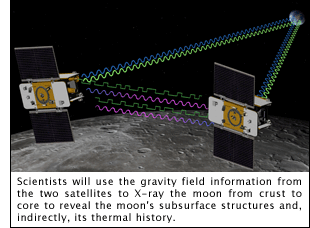 GRAIL: The Gravity Recovery and Interior Laboratory mission is a part of NASA's Discovery Program. It is scheduled to launch in 2011. GRAIL will fly twin spacecraft in tandem orbits around the moon for several months to measure its gravity field in unprecedented detail. The mission also will answer longstanding questions about Earth's moon and provide scientists a better understanding of how Earth and other rocky planets in the solar system formed. Maria is the principal investigator on this exciting, cutting-edge mission. GRAIL: The Gravity Recovery and Interior Laboratory mission is a part of NASA's Discovery Program. It is scheduled to launch in 2011. GRAIL will fly twin spacecraft in tandem orbits around the moon for several months to measure its gravity field in unprecedented detail. The mission also will answer longstanding questions about Earth's moon and provide scientists a better understanding of how Earth and other rocky planets in the solar system formed. Maria is the principal investigator on this exciting, cutting-edge mission.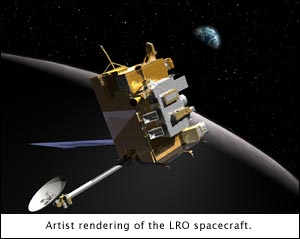 LRO: The Lunar Reconnaissance Orbiter is the first mission in NASA's Vision for Space Exploration, a plan to return to the moon and then to travel to Mars and beyond. The LRO objectives are to finding safe landing sites, locate potential resources, characterize the radiation environment, and demonstrate new technology. Maria is co-leader of investigations to perform high-resolution topographic mapping and the first operational optical tracking of a planetary spacecraft. Members of the MIT Kavli Institute for Astrophysics and Space Research are also participating in an experiment to characterize the lunar radiation environment. The spacecraft was launched on June 19, 2009. LRO: The Lunar Reconnaissance Orbiter is the first mission in NASA's Vision for Space Exploration, a plan to return to the moon and then to travel to Mars and beyond. The LRO objectives are to finding safe landing sites, locate potential resources, characterize the radiation environment, and demonstrate new technology. Maria is co-leader of investigations to perform high-resolution topographic mapping and the first operational optical tracking of a planetary spacecraft. Members of the MIT Kavli Institute for Astrophysics and Space Research are also participating in an experiment to characterize the lunar radiation environment. The spacecraft was launched on June 19, 2009.(SETG) The Search for Extraterrestrial Genomes SETG will test the hypothesis that life on Mars, if it exists, shares a common ancestor with life on Earth. There is increasing evidence that viable microbes could have been transferred between the two planets, based in part on calculations of meteorite trajectories and magnetization studies supporting only mild heating of meteorite cores. Based on the shared-ancestry hypothesis, this instrument will look for DNA and RNA through in-situ analysis of Martian soil, ice, or brine samples. By applying recent advances in microfluidics, embedded systems, and biological automation, our team is developing an instrument that can isolate, amplify, detect, and classify any extant DNA or RNA-based organism. 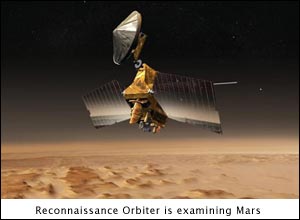 MRO: Mars Reconnaissance Orbiter is a multipurpose spacecraft launched on Aug. 12, 2005 to advance our understanding of Mars through detailed observation, to examine po-tential landing sites for future surface missions and to provide a high-data-rate communications relay for those missions. Scientists are using the spacecraft to study the surface, monitor the atmosphere, and probe underground, all to gain better knowledge of the distribution and history of Mars' water, whether frozen, liquid or vapor. Carrying the most powerful telescopic camera ever flown to another planet, Mars Reconnaissance Orbiter resolves Martian landscape features as small as a kitchen table from the spacecraft's low orbital altitude. To pour the data back to Earth at more than 10 times the rate of any previous Mars mission, the spacecraft uses a wider antenna dish, a faster computer and an amplifier powered by a bigger solar-cell array. MRO: Mars Reconnaissance Orbiter is a multipurpose spacecraft launched on Aug. 12, 2005 to advance our understanding of Mars through detailed observation, to examine po-tential landing sites for future surface missions and to provide a high-data-rate communications relay for those missions. Scientists are using the spacecraft to study the surface, monitor the atmosphere, and probe underground, all to gain better knowledge of the distribution and history of Mars' water, whether frozen, liquid or vapor. Carrying the most powerful telescopic camera ever flown to another planet, Mars Reconnaissance Orbiter resolves Martian landscape features as small as a kitchen table from the spacecraft's low orbital altitude. To pour the data back to Earth at more than 10 times the rate of any previous Mars mission, the spacecraft uses a wider antenna dish, a faster computer and an amplifier powered by a bigger solar-cell array.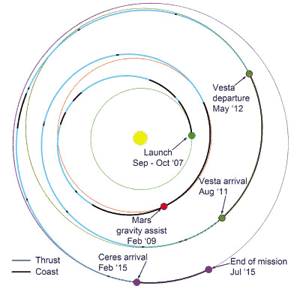 DAWN: Dawn's goal is to characterize the conditions and processes of the solar system's earliest epoch by investigating in detail two of the largest protoplanets remaining intact since their formations. Ceres and Vesta reside in the extensive zone between Mars and Jupiter together with many other smaller bodies, called the asteroid belt. Each has followed a very different evolutionary path constrained by the diversity of processes that operated during the first few million years of solar system evolution.
Maria is part of the science team for this exciting project. You can track mission progress by subscribing to the DAWN newsletter here. DAWN: Dawn's goal is to characterize the conditions and processes of the solar system's earliest epoch by investigating in detail two of the largest protoplanets remaining intact since their formations. Ceres and Vesta reside in the extensive zone between Mars and Jupiter together with many other smaller bodies, called the asteroid belt. Each has followed a very different evolutionary path constrained by the diversity of processes that operated during the first few million years of solar system evolution.
Maria is part of the science team for this exciting project. You can track mission progress by subscribing to the DAWN newsletter here. 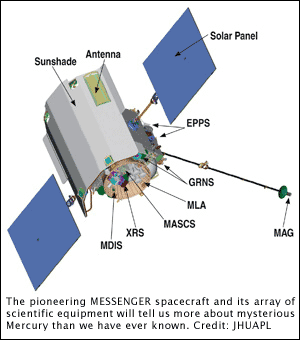 MESSENGER: Mercury Surface, Space ENvironment, GEochemistry, and Ranging is a 4.9-billion mile (7.9-billion kilometer) journey that includes 15 trips around the sun, a flyby of Earth, two of Venus and three of Mercury before easing into orbit around its target planet, Mercury. With a package of seven science instruments MESSENGER will determine Mercury's composition; image its surface globally and in color; map its magnetic field and measure the properties of its core; explore the mysterious polar deposits to learn whether ice lurks in permanently shadowed regions; and characterize Mercury's tenuous atmosphere and Earth-like magnetosphere. MESSENGER: Mercury Surface, Space ENvironment, GEochemistry, and Ranging is a 4.9-billion mile (7.9-billion kilometer) journey that includes 15 trips around the sun, a flyby of Earth, two of Venus and three of Mercury before easing into orbit around its target planet, Mercury. With a package of seven science instruments MESSENGER will determine Mercury's composition; image its surface globally and in color; map its magnetic field and measure the properties of its core; explore the mysterious polar deposits to learn whether ice lurks in permanently shadowed regions; and characterize Mercury's tenuous atmosphere and Earth-like magnetosphere. The Mercury Laser Altimeter (MLA) will create topographic maps of the planet's surface in unprecedented detail. When the laser shines down and reflects off Mercury's surface, a sensor will gather the light, allowing scientists to track variations in the distance from the surface to the spacecraft. As MESSENGER orbits Mercury's surface, the spacecraft will be attracted to areas where the mass is greater and gravity tugs a little harder, causing it to speed up slightly as it approaches and slow a bit as it recedes. The Radio Science experiment will use the Doppler Effect to track the changes in MESSENGER's velocity, and translate them into clues to how the planet's mass is distributed and where the crust is thicker or thinner. 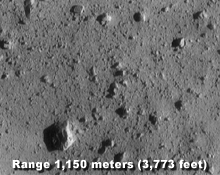 Near Earth Asteroid Rendezvous (NEAR) Near Earth Asteroid Rendezvous (NEAR)The Near Earth Asteroid Rendezvous (NEAR) mission is the first launch in the Discovery Program, an initiative of NASA for small planetary missions. NEAR is managed for NASA by The Johns Hopkins University Applied Physics Laboratory. The NEAR mission objective is to orbit an asteroid for a year and collect data from a suite of sensors. The target asteroid is 433 Eros, the second largest Earth-crossing asteroid. As the first spacecraft to orbit an asteroid, NEAR promises to provide observations that will be invaluable towards answering fundamental questions about the nature and origin of near-Earth objects, such as the numerous asteroids and comets in the vicinity of Earth's orbit. The NEAR mission will make the first quantitative and comprehensive measurements of an asteroid's composition and structure. The measurements have been identified by the National Academy of Sciences as the most important scientific objectives in the exploration of primitive bodies. Primary scientific goals of the NEAR mission are to measure:
CLEMENTINE In 1994, an experimental satellite was launched with a goal of testing lightweight sensors and advanced components in space for long periods of time. The results were greater than expected, providing detailed images of the earth, a complete map of the moon, and a verification that there is ice on the moon. The project was known as Clementine. Much of the data collected during the mission can be accessed here. We offer still images, animations, and a lunar map with metadata features. We also have detailed information about the project that was donated to the Smithsonian. All are available through this website's menu to the left. Clementine was jointly sponsored by the Ballistic Missile Defense Organization and NASA. The BMDO assigned responsibility for the Clementine spacecraft design, manufacture, integration, and mission execution to the Naval Research Laboratory. The Lawrence Livermore National Laboratory provided lightweight imaging sensors. Mars Observer After a 17-year gap since its last mission to the red planet, the United States launched Mars Observer on September 25, 1992. The spacecraft was based on a commercial Earth-orbiting communications satellite that had been converted into an orbiter for Mars. The payload of science instruments was designed to study the geology, geophysics and climate of Mars. The mission ended with disappointment on August 22, 1993, when contact was lost with the spacecraft shortly before it was to enter orbit around Mars. Science instruments from Mars Observer are being reflown on two other orbiters, Mars Global Surveyor and 2001 Mars Odyssey. |
 |
 |